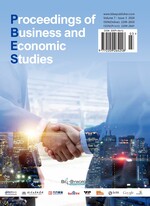Abstract
The comprehensive development level of the business environment reflects the quality of a region’s economic development, and a good business environment will give a city a strong vitality. This paper uses the entropy method to measure and evaluate the business environment of 106 large and medium-sized cities in China from 2017 to 2021. The results show that: From the spatial point of view, the business environment index of China’s cities shows a gradually decreasing pattern from east to west and from south to north. The balance of the business environment of large and medium-sized cities in China is divided into four levels according to the standard deviation of the ranking of each sub-index. The greater the standard deviation, the more unbalanced the overall development of the business environment in the region. Finally, this paper put forward countermeasures and suggestions to further optimize the business environment.
References
Peng D, Chen B, Liu Z, 2019, Business Environment Evaluation Index System – An Example of Yangtze River Economic Belt. Journal of Finance and Economics, 2019(5): 49–55.
Dong Z, Wei X, Tang C, Institutional Soft Environment and Economic Development – An Empirical Study of Business Environment in 30 Big Cities. Management World, 2012(4): 9–20.
World Bank, 2022, Ease of Doing Business 2023, viewed January 5, 2024, https://archive.doingbusiness.org/zh/doingbusiness
Liu Y, Wu W, Li Y, 2020, Study on the Development and Evaluation of Chinese Business Environment. Regional Economic Review, 2020(1): 70–78.
“Research on the Evaluation of Business Environment in Chinese Cities” Project Team, Li Z, Zhang S, et al., 2021, Theoretical Logic, Comparative Analysis and the Countermeasures of Doing Business Assessment in Chinese Cities. Journal of Management World, 37(5): 98–112 + 8.
Li Z, 2021, Evaluation of the Business Environment in Chinese Cities. China Development Press, Beijing.
Huang L, Zhang H, 2023, Evaluation of China’s Business Environment and Analysis of Temporal and Spatial Evolution Characteristics. Statistics and Decision, 39(16): 157–162.
Fan H, Wu T, He S, 2022, How Does “Internet+Government Services” Platform Optimize City’s Doing Business Environment? A Study Based on Interactive Governance Perspective. Journal of Management World, 38(10): 126–153.
Qiu K, Chen J, Lv Y, 2022, Study on the Measurement, Regional Differences and Dynamic Evolution of the Comprehensive Development Level of Business Environment in China. The Journal of Quantitative & Technical Economy, 39(2): 121–143.
Zhang W, Bai Y, 2022, Theoretical Construction, Empirical Analysis and Optimization Path of the Coupling of Digital Economy and Rural Revitalization. China Soft Science, 2022(1): 132–146.
Tong Y, 2019, Some Problems and Solutions to Create a High-Quality Development Environment for Private Economy. Economic Review Journal, 2019(4): 52–58.
Estevão J, Lopes JD, Penela D, et al., 2020, The Doing Business Ranking and the GDP: A Qualitative Study. Journal of Business Research, 115: 435–442. https://doi.org/10.1016/j.jbusres.2019.11.067
Adhikari T, Whelan K, 2023, Did Raising Doing Business Scores Boost GDP? Journal of Comparative Economics, 51(3): 1011–1030. https://doi.org/10.1016/j.jce.2023.04.003
Zhang S, Kang B, Zhang Z, 2020, Evaluation of Doing Business in Chinese Provinces: Indicator System and Quantitative Analysis. Business and Management Journal, 42(4): 5–19.
Qian X, Liu D, Huang L, et al., 2022, Distance of Doing Business and Outward Foreign Direct Investment: An Empirical Study of China. Review of Development Economics, 26(3): 1411–1437. https://doi.org/10.1111/rode.12890
